Pharm Exec's 2019 Pipeline Report
Pharmaceutical Executive
As CAR-T therapy eyes new territory-solid tumors-and expands into autoimmune disease, other frontiers in drug development are beginning to open up. They highlight the raw promise of science, with cannabis-based agents targeting CNS and rare genetic disorders, as well as the larger responsibility to public health, including advancing non-opioid alternatives, addressing antibiotic, and untangling the path to market for biosimilars.
New Bets, Wider Threats
As CAR-T therapy eyes new territory-solid tumors-and expands into autoimmune disease, other frontiers in drug development are beginning to open up. They highlight the raw promise of science, with cannabis-based agents targeting CNS and rare genetic disorders, as well as the larger responsibility to public health, including advancing non-opioid alternatives, addressing antibiotic resistance, and untangling the path to market in the still-contentious US biosimilars arena
Where is science taking the future of medicine? Pharm Exec’s 15th Annual Pipeline Report explores those possibilities ahead, with in-depth overviews of the most active, emerging-and critical-areas of therapeutic focus in biopharma R&D today. As in years past, promising product candidates in each category are highlighted-the new targets, new modalities, and new technologies paving the road from basic science to potential commercial success and ultimately an impact on the wider healthcare ecosystem.
Pharm Exec would like to acknowledge Pharma Intelligence, part of Informa Group plc, for providing supportive data in the report and accompanying charts.
Advancing CAR-T
From leukemia to lymphoma, advances in diagnosing and treating blood cancers have optimized survival rates. Efforts involving chimeric antigen receptor (CAR)-T (gene) therapy are transitioning from blood cancers to a new target: solid tumors. Recent efforts involve both CAR-T therapies and tumor agnostic drugs-treatments specifically directed at cancers that contain certain molecular signatures.
Kindling hope for patients was the FDA approval in 2017 of Novartis’ Kymriah for treating acute lymphoblastic leukemia (ALL) in certain pediatric and young patients, and Gilead Sciences/Kite Pharma’s Yescarta, for adults with certain large B-cell lymphomas. Also making a move in the CAR-T arena was Celgene, which acquired Juno Therapeutics in January 2018. Juno has pioneered CAR-T and TCR (T-cell receptor) research, establishing

a portfolio with potential therapies for several cancer indications. Added to Celgene’s lymphoma program is JCAR017, a CD19-directed CAR-T product in a pivotal program for relapsed or refractory diffuse large B-cell lymphoma (DLBCL). FDA approval may come in 2019. The drug has potential global peak sales of about $3 billion.
While the scientific road for CAR-T does not dead-end with hematologic cancers, therapies for solid tumors are challenging because the tumors are surrounded by a hostile, immuno-suppressive environment that keeps CAR-T cells out. They must be engineered with components that increase their activity in these environments.
“Lots of eyes will be watching the feasibility of CAR-T therapies on the market as uptake has been slow,” says Madelyn Hanson, manager, oncology consulting services, clinical and scientific assessment, at Kantar Health. “Many do hope that CAR-Ts can hit the mainstream, and that more cell therapies are able to achieve what has been seen already with approved therapies.”
In August, Seattle Children’s Hospital initiated a CAR-T cell trial for children and young adults who have relapsed or refractory non-central nervous system epidermal growth factor receptor (EGFR)-expressing solid tumors. In the Phase I trial,

STRIvE-01, CAR-T cells target the EGFR protein expressed in childhood sarcoma, kidney, and neuroblastoma tumors. Scientists will engineer CAR-T cells with the EGFR806 antibody that has significant antitumor activity. It may selectively recognize tumor cells expressing EGFR.
Other solid tumor efforts
Besides CAR-T, other adoptive cell transfer (ACT) therapies are targeting solid tumors. Also in research are TCR-engineered T cells. Locating proteins on tumor cells that are not present in normal tissue has been an impediment, notably regarding solid tumors.
Present in T cells, TCRs are natural receptors that recognize peptides derived from chopped proteins that may include antigens specific to cancer cells. TCRs recognize proteins that are not present in the plasma membrane-a requirement for CARs. This broadens the potential for targeting more proteins found on tumor cells.
RXi Pharmaceuticals is developing immuno-oncology therapeutics, to be used with ACT, based on its self-delivering RNAi (sd-rxRNA) platform.The process uses immune cells, such as T-lymphocytes, that are isolated from the patient or retrieved from allogeneic immune cell banks, and then expanded to express tumor-binding receptors.
Also addressing solid tumors are Tarveda Therapeutics' Pentarins-powerful and selective miniature drug conjugates with high affinity for specific cell surface and intracellular targets. Pentarins bind to tumor cell targets and offer sustained release into solid tumor tissue.
Tarveda’s lead Pentarin clinical drug candidate, PENâ221, targets the somatostatin receptor 2 (SSTR2) to treat patients with tumors, including neuroendocrine, small cell lung, and other cancers, which express SSTR2. PEN-221 has a peptide highly selective for SSTR2. It is in a Phase IIa trial in patients with gastrointestinal midgut neuroendocrine tumors, pancreatic neuroendocrine tumors, or small cell lung cancer.
Meanwhile, Erytech’s pivotal Phase III trial with eryaspase in second-line pancreatic cancer is open for enrollment. The company is launching a Phase II trial in first-line triple-negative breast cancer.
Tumor agnostic therapies
Novel therapies that target genetic mutations independent of where a tumor is located-tumor agnostic therapies-represent a new paradigm in solid tumor treatment. Unlike drugs that target specific biomarker-positive tumors, tumor agnostic therapy is based on a biomarker that determines the disease regardless of its location in the body. Such an approach might make it easier to match patients to the best clinical trial and the best treatment.
In May 2017, Merck & Co.’s checkpoint inhibitor immunotherapy, Keytruda, became the first FDA-approved cancer treatment that was based on whether a tumor had a specific genetic mutation, not specifically on the organ in which the tumor arose. In September, the European Commission approved Keytruda, in combination with pemetrexed (Alimta) and platinum chemotherapy, for first-line treatment of metastatic nonsquamous non-small cell lung cancer (NSCLC) in adults whose tumors have no EGFR- or anaplastic lymphoma kinase (ALK)-positive mutations. But in April, a Phase III trial assessing the combination of Incyte’s lead cancer immunotherapy candidate, epacadostat, and Merck’s Keytruda in melanoma was halted after the combo therapy failed the pivotal study.
Recently though, IMV, a clinical-stage immuno-oncology company, expanded its clinical program by collaborating with Merck to undertake a significant basket trial. In the Phase II study, scientists will evaluate IMV’s lead candidate, DPX-Survivac, in combination with low-dose cyclophosphamide and Keytruda, in patients with certain advanced or recurrent solid tumors, such as bladder, liver, and ovarian tumors, among others.
Historically, clinical trials, even for a single biomarker, are done in a specific tumor type, This is not the case with tumor agnostic therapies. Hanson expects these drugs to reach more patients much faster because tumor agnostic therapies will not be undergoing multiple clinical trials for individual tumor types. Unfortunately, she explains, some physicians are unsure as to which tumors they can treat with these therapies.
Using the tumor agnostic approach, Loxo Oncology is developing its tropomyosin receptor kinase (TRK) fusion inhibitor, larotrectinib. TRKs are abnormal proteins that promote tumor cell growth. The compound stops TRK fusion activity. Larotrectinib is in a Phase II basket trial for solid cancers harboring TRK alterations, such as tumors of the central nervous system. Another TRK inhibitor, Loxo-195, for potential acquired resistance in patients receiving larotrectinib or multikinase inhibitors with anti-TRK activity, is in a currently enrolling Phase I/II trial.
Meanwhile, Roche plans to file for approval of entrectinib, which the company acquired when it bought Ignyta in 2017. In September, Roche reported that entrectinib shrunk tumors in 77.4% of those with locally advanced or metastatic ROS1-positive NSCLC. Entrectinib also shrunk tumors in more than half of people with cancer in the central nervous system.
CAR-T’s next frontier: Autoimmune disease
CAR-T therapies are also being explored in the fight against autoimmune diseases. Most current treatments only control symptoms, but scientists in early research at the University of Pennsylvania have used CAR-T technology as a key component of a strategy to remove the subset of antibody-making cells that cause autoimmune disease, without harming the rest of the immune system.
In October, Sangamo Therapeutics acquired TxCell, which is developing personalized T cell immunotherapies for treating severe inflammatory and autoimmune diseases with high unmet medical need. The company is harnessing regulatory T cells (CAR-Treg). Sangamo is targeting transplantation and other autoimmune diseases, both T-cell and B-cell mediated, including multiple sclerosis, rheumatoid arthritis, inflammatory bowel diseases, and inflammatory skin diseases. The company’s TX200 for transplant rejection is in the preclinical stages, with a clinical trial application filing planned for the first half of 2019.
Atara Biotherapeutics has also expanded its collaboration with Memorial Sloan Kettering Cancer Center to develop the next generation of CAR-T immunotherapies, targeting oncology, autoimmune, and infectious diseases.
Confronting the opioid crisis
On a backdrop of public outcry and increased litigation against opioid makers, non-opioid therapies are in demand. And the potential market size is a driver. BCC Research estimates the global non-opioid pain treatment market to reach about $22 billion in 2022. FDA is encouraging development of alternatives and aims to publish

documentation facilitating drug development targeting specific pain types. The idea behind this approach is smaller clinical trials and more rapid drug approvals.
In terms of drug development activity, Nektar Therapeutics’ NKTR-181, in Phase III, is a form of oxycodone to which is linked polyethylene glycol. For treating moderate-to-severe chronic low back pain, the candidate causes a slower release of dopamine. Meanwhile, Astraea Therapeutics’ AT-121 is in preclinical development, in investigational new drug (IND)-enabling studies. The therapy stimulates two molecules in the brain simultaneously: MOR, the µ-opioid receptor, and the nociceptin opioid receptor (NOR). When activated in the brain, NOR reportedly acts against MOR. But, simultaneously, NOR reinforces MOR’s pain-relieving activity in the body’s central nervous system.
In September, Aptinyx highlighted preclinical data on its novel N-methyl D-aspartate (NMDA) receptor modulator, NYX-2925, that support the company’s ongoing clinical development for treating chronic pain. The drug is in Phase II trials for painful diabetic peripheral neuropathy and fibromyalgia. The data demonstrate strong mechanistic support for developing NYX-2925 as a potential therapy for chronic pain conditions. FDA has granted fast-track designation to NYX-2925 for treating neuropathic pain associated with diabetic peripheral neuropathy.
Recro Pharma is developing non-opioid products for acute pain. The company’s lead candidate is a proprietary injectable form of meloxicam. This intravenous (IV) meloxicam has successfully completed several Phase II clinical trials for treating moderate-to-severe pain. Recro has responded to an FDA complete response letter regarding its new drug application (NDA) for NYX-2925, resubmitting the NDA with revised language relating to the product label and more data involving extractable and leachable items.
Tremeau Pharmaceuticals is developing TRM-201 (rofecoxib) as a fast-track, first-approved treatment for hemophilic arthropathy, for which high-potency opioids are currently used. The company also is developing TRM-359 (etoricoxib) as a breakthrough, first-approved therapy for a serious pediatric orphan disease treated now using high-potency opioid drugs.
In September, Purdue Pharma announced that it is providing $3.4 million to Harm Reduction Therapeutics to develop its OTC naloxone nasal spray. The opioid antagonist naloxone counteracts the effects of a life-threatening opioid overdose.
Click to enlarge
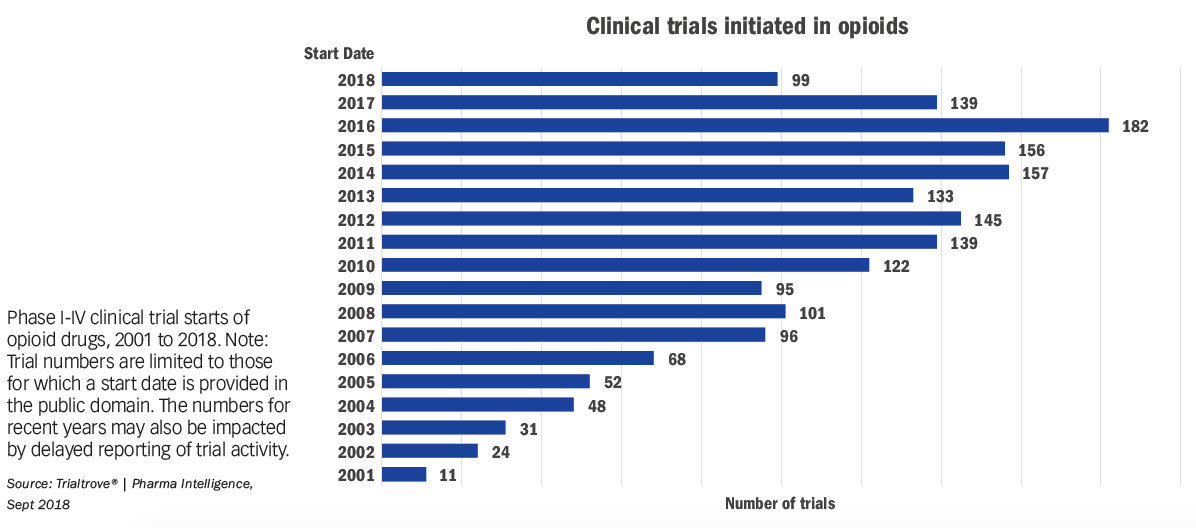
New world of cannabis
A lack of standardized tests for the cannabis plant impedes scientific-based evaluations of test results usually required of approved therapeutics. Standardized testing would clarify concerns about potency, actual cannabidiol (CBD) content, and the presence of residual contaminants.
These issues will almost certainly be worked out, however, and have not stopped a slew of companies from moving forward in developing prescription therapies, targeting several disorders, including autism, schizophrenia, cystic fibrosis, and fibromyalgia, among others.
This past summer marked a milestone when FDA approved the first prescription pharmaceutical derived from the cannabis plant, GW Pharmaceuticals’ lead cannabinoid compound, Epidiolex, an oral solution for treating seizures associated with Dravet and Lennox-Gastaut syndromes in patients two-years old and older. Both
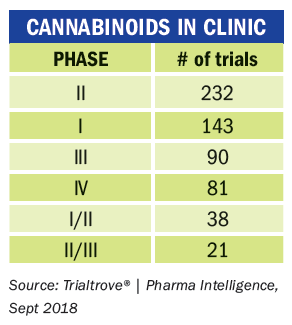
diseases are rare, severe forms of childhood-onset epilepsy that are treatment challenges.
In late September, the Drug Enforcement Administration (DEA) approved CBD as a Schedule V controlled substance. The order places FDA-approved drugs that contain CBD derived from cannabis and no more than 0.1% tetrahydrocannabinols (THCs) in Schedule V, allowing for its sale in the US by GW Pharmaceuticals and opening the door for other companies to sell cannabis-based therapeutics.
There are still issues to be addressed, however, such as the unfamiliarity with cannabis on the part of some physicians, who may hesitate to write prescriptions. GW’s plan to educate physicians on the benefits of Epidiolex has involved hiring more than 60 neurology sales reps who will target about 5,000 epilepsy specialists.
Epidiolex is also in Phase III clinical studies for treating tuberous sclerosis. GW’s Sativex is an oromucosal spray of a formulated extract of the cannabis sativa plant that contains cannabinoids delta-9-THC and CBD in a 1-to-1 ratio, as well as other cannabinoids and non-cannabinoids.
In Europe, Sativex has marketing authorization in 21 countries for treating spasticity, muscle stiffness, and spasm caused by multiple sclerosis. In the US, the drug is in Phase III testing for MS spasticity. Cannabidivarin
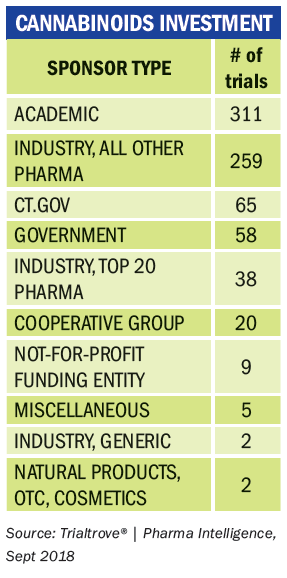
(CBDV) is a non-psychoactive cannabinoid that does not cause euphoria. GW is developing it for epilepsy and autism spectrum disorders.
Elsewhere, Nemus Bioscience has seven drugs in early-phase development. Among them are NB1111, a prodrug THC for treating glaucoma, and NB1222, also a prodrug THC, for treating chemotherapy-induced nausea and vomiting. Both candidates are in the preclinical stage.
Zynerba Pharmaceuticals’ pharmaceutically-produced CBD and lead-product candidate, ZYN002, is under evaluation in several rare and near-rare neuropsychiatric disorders. It is a gel that is in pivotal studies for fragile X syndrome. ZYN002 has completed Phase II studies for developmental and epileptic encephalopathies and Phase II trials for adult refractory focal seizures.
Corbus Pharmaceuticals is developing lenabasum, a synthetic, oral, small-molecule, selective cannabinoid receptor type 2 (CB2) agonist that showed in animal studies to preferentially bind to CB2 expressed on activated immune cells and fibroblasts. Activation triggers physiologic pathways that correct inflammation, speed bacterial clearance, and halt fibrosis. The candidate is in Phase III clinical studies for systemic sclerosis and dermatomyositis; and in Phase II trials for systemic lupus and cystic fibrosis.
In September, Corbus licensed from Jenrin Discovery the exclusive worldwide rights to candidates from more than 600 compounds targeting the endocannabinoid system. The portfolio includes CRB-4001, a CB1 inverse agonist that is to enter a Phase I study in 2019 followed by a NIH-supported Phase II study.
Cara Therapeutics has evaluated CR701 in a rodent model of neuropathic pain that produces both hyperalgesia (sensitization of nerve endings to painful stimuli) and allodynia (painful perception of innocuous stimuli) comparable to human conditions. CR701 in animals with neuropathy significantly reversed hyperalgesia and allodynia.
Insys is developing a CBD oral solution for childhood absence epilepsy, infantile spasms, and Prader-Willi syndrome, a genetic disorder caused by a loss of function of certain genes. Kalytera is developing a clinical-stage CBD to prevent and treat graft-versus-host disease. The company also is designing a treatment for acute and chronic pain using a compound that consists of a cannabinoid conjugated with naproxen, a generic, non-steroidal, anti-inflammatory drug approved for treating pain. The goal is to develop a well-tolerated potent, non-psychotropic, oral analgesic for intractable pain.
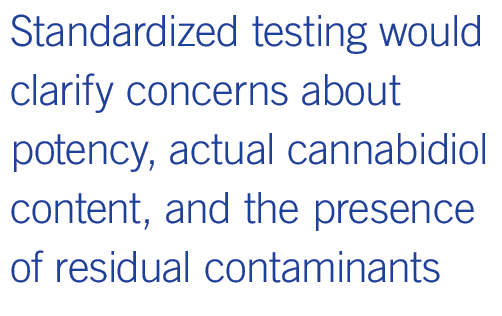
Also in play is Artelo Biosciences, which is developing high-potency cannabinoid receptor 1 and 2 agonists. The candidates have completed Phase I trials for anorexia and cachexia, and are in preclinical work for cancer. In August, Revive submitted an application to FDA seeking orphan-drug designation of CBD for treating hepatic ischemia and reperfusion injury during liver transplantation. Two months earlier, FDA had granted Revive orphan-drug status for CBD for treating autoimmune hepatitis.
In September, GB Sciences selected Catalent Pharma Solutions to provide oral delivery systems, formulation development, and clinical-scale oral dose manufacturing of GB Sciences’ proprietary cannabinoid-containing active pharmaceutical ingredients for its Parkinson’s disease therapies.
Biosimilar stagnation
FDA’s approval of a dozen biosimilars so far trails noticeably behind activity in Europe, where the European Medicines Agency (EMA) has approved more than 40 biosimilars. In the US, many companies with brand products are pushing to delay competition. Makers of biosimilars have protested actions that block access to reference products needed for new drug testing. Pfizer filed a citizen petition with FDA asking the agency to halt misinformation on biosimilar safety and use from reference product manufacturers, citing false and
Biosimilars & Big Pharma; click to enlarge
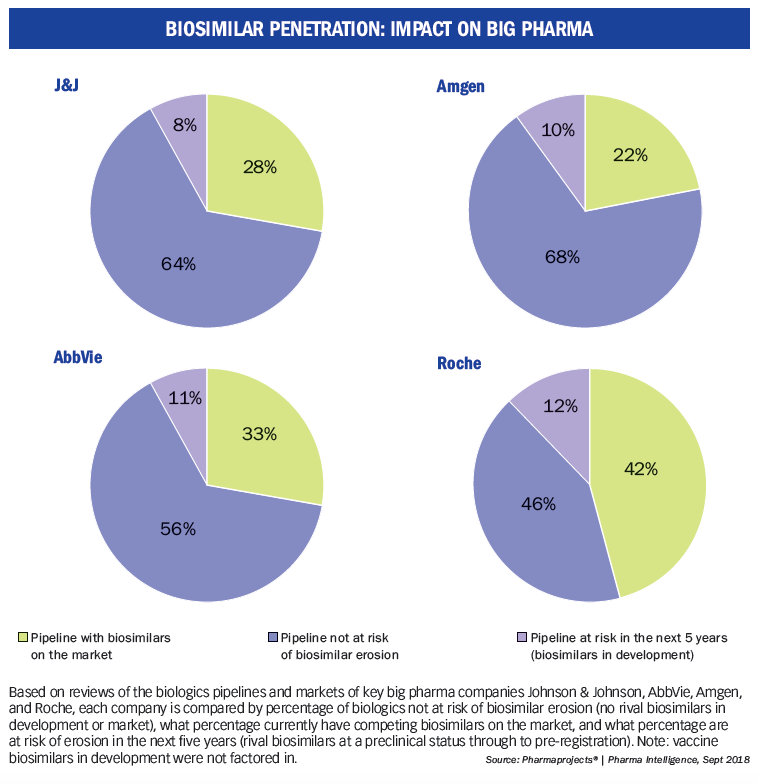
misleading statements from innovators suggesting biosimilars are not as safe or effective as brands and have slowed prescribing and uptake of the new competitors.
In its Blueprint to Lower Drug Prices and Reduce Out-of-Pocket Costs, the Department of Health and Human Services (HHS) stated that FDA would issue new policies to improve the availability, competitiveness, and adoption of biosimilars as affordable alternatives to branded biologics. Over the summer, FDA unveiled its Biosimilars Action Plan, listing initiatives for establishing a more efficient review process, including greater scientific and regulatory clarity for sponsors, and tools for using modern analytical techniques.
Still, there remain several regulatory issues to be considered, including testing requirements to document interchangeability; product naming to distinguish biosimilars from reference drugs and limit prescribing; and suggestions that switching from one interchangeable therapy to another raises additional safety concerns. Other key issues involve ongoing patent challenges and challenging payment policies that stymie biosimilar coverage and prescribing. More complex testing requirements push biosimilar development costs up to $250 million per program, compared with $10 million needed to produce a new generic drug.
Despite the issues, research continues. In May, Coherus BioSciences resubmitted its biologics license application (BLA) for CHS-1701, a pegfilgrastim (Amgen’s Neulasta) biosimilar candidate, to FDA using the 351(k) pathway. The company’s CHS-1420 adalimumab (AbbVie’s Humira) has completed Phase III clinical

studies in psoriasis.
Novartis’ Sandoz unit plans to launch several biosimilars of key oncology and immunology biologics by 2020, including an approved Erelzi, a biosimilar to Amgen’s Enbrel, as well as biosimilars of Humira (adalimumab), Neulasta (pegfilgrastim), Remicade (infliximab), and Rituxan (rituximab).
Celltrion’s pipeline contains six antibody biosimilars, including Remsima SC, (Janssen’s Remicade) and CT-P16 (Genentech’s Avastin). In August, Celltrion finalized trials for Remsima SC and intends to file a marketing authorization application to EMA late 2018. Its bevacizumab biosimilar, CT-P16, is ready for Phase III trials.
Amgen is involved on both sides of biosimilars. The company gained FDA approval for the first biosimilar version of AbbVie’s Humira, as well as for its and Allergan’s Mvasi, a biosimilar of Roche’s blockbuster drug Avastin. But Amgen is fiercely defending its biologics portfolio, including Enbrel, Neulasta, and Neupogen from biosimilars made by others. Amgen also is in court against Sandoz over the patent validity and protection of Enbrel.
The pipeline is small for biosimilar vaccines (see chart below). EyeGene and Chong Kun Dang Pharmaceutical are in Phase I trials with EG-HPV, a recombinant bivalent vaccine containing human papilloma virus HPV-16 and HPV-18 virus-like particles. It is for preventing cervical cancer caused by the human papillomavirus, according to Medtrack data.
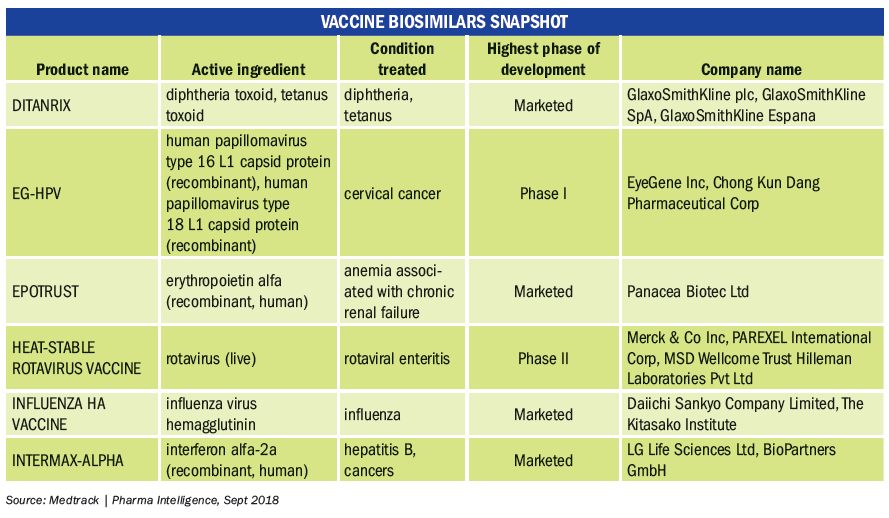
Merck, the CRO Parexel, and Hilleman Laboratories-a partnership between Merck and Wellcome Trust-are in Phase II trials with a heat-stable rotavirus vaccine that elicits antibody responses that neutralize diseased antigens. The vaccine is indicated for preventing gastroenteritis caused by rotavirus infection, Medtrack reports.
Alzheimer’s failing to fulfill
Les Funtleyder, healthcare portfolio manager at E Squared Capital Management, and a Pharm ExecEditorial Advisory Board (EAB) member, points out that “Nothing has worked for Alzheimer’s, and nothing seems to be on the horizon.” He adds: “Investors would want a lot of certainty regarding a mechanism of action before they encourage pharma to put real money behind it.” And without functional outcomes with biomarkers, Funtleyder questions whether they would receive regulatory approval.
“We need to find a way to attack Alzheimer’s disease and other forms of cognitive impairment early on,” says Dr. Edward I. Ginns, medical director, neurology for Quest Diagnostics. (Quest developed CogniSense, a cognition test available as an iPad app and given in the primary care doctor’s office.) If researchers can go back and identify specific processes involved in cognitive impairment, they may find that some Alzheimer’s
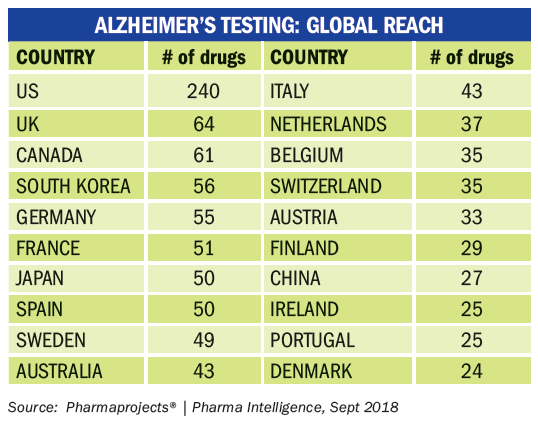
interventions-which were not therapeutic when the brains neurons were beyond saving-might be successful at an earlier stage, Ginns adds. Another option, he says, might involve regenerative therapy that replaces neurons no longer active.
The frustration in the Alzheimer’s space caused Pfizer to terminate its research efforts in Alzheimer’s and Parkinson’s diseases. And Eli Lilly’s solanezumab did not have much positive effect in those with the mildest form of Alzheimer’s disease. But in January, Johnson & Johnson and Janssen Pharmaceuticals began working with the University of Pennsylvania’s Gene Therapy Program, using adeno-associated virus (AAV)-vectors developed by the university and antibodies targeting Alzheimer’s disease developed by Janssen. The effort harnesses AAV viral gene delivery to express therapeutic antibodies that target the main pathological hallmarks of Alzheimer’s disease (see the most active clinical targets and mechanisms of action in Alzheimer's on page 24).
Earlier this year, Biogen and Eisai’s Phase II results for BAN2401 generated some hopes for amyloid efforts. The compound is the humanized IgG1 version of the mouse monoclonal antibody mAb158, and targets beta-amyloid protein fragments that accumulate in the brain. While data showed that BAN2401 had a significant effect on cognitive decline in mild Alzheimer's patients at 18 months, newer results unveiled last month found that the drug may only work in a small subset of patients-those who carry the APOE4 protein. And these patients are reportedly also susceptible to brain swelling.
In other anti-amyloid activity, Genentech-Roche’s antibody crenezumab was found in two Phase II trials to lower amyloid beta oiligomer levels in the cerebrospinal fluid of most patients.
Need for novel antibiotics
Antibiotics, magic bullets that save thousands of lives, have become less effective thanks to resistant bacteria. Simple surgeries and other procedures might become extremely risky without antibiotics that can reliably prevent infection. In the US, at least two million people have an antibiotic-resistant infection, and at least 23,000 people die annually, according to the Centers for Disease Control and Prevention (CDC). The World Health Organization (WHO) is warning that the current antibiotic pipeline will not be enough to combat future threats.
Dr. Kenneth I. Kaitin, professor and director of the Tufts Center for the Study of Drug Development at the Tufts University School of Medicine, and also a Pharm ExecEAB member, notes a paradox. “Society is willing to spend a lot of money on cancer drugs that will add just a few months to a patient’s lifetime, but antibiotics, which could actually save patients’ lives, are expected to be relatively cheap,” he says. “As a result, companies hesitate to invest in developing new antibiotics.”
Kaitin explains that there is “a less appealing reimbursement landscape” for drugmakers in the antibiotic space, compared with oncology therapeutics. Many companies have stopped investing in antibiotics development because of an inability to generate desired revenue, he adds. “Moreover, new scientific knowledge often drives innovative research activity,” says Kaitin. “What is needed is more basic research to stimulate interest in developing novel antibiotics.”
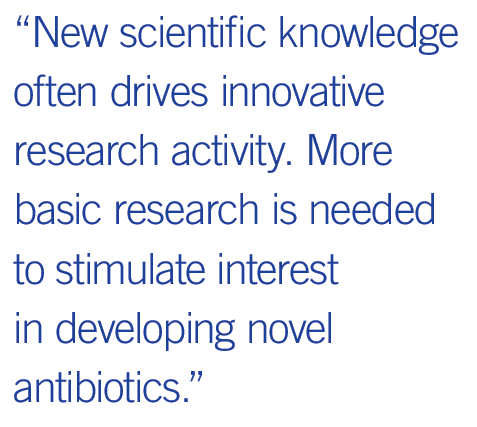
Meanwhile, FDA is collaborating with other federal agencies and biomedical researchers to advance the science, regulatory policies, and reimbursement strategies to support innovation. The issue: payment and coverage policies for new drugs encourage widespread use of the products to generate a sufficient return on investment to companies sponsoring research on new treatments. But to remain effective against lethal pathogens, new antimicrobials must be used very sparingly, cutting revenues in the process.
FDA Commissioner Scott Gottlieb has outlined proposals for devising innovative milestone payments and subscription fees for developers of products targeted at multi-drug resistant organisms. But it remains to be seen if incentives will spark renewed interest in antibiotic discovery and development.
Drugs in late-stage development that WHO thinks are innovative and are expected to act against “priority” pathogens include Merck’s relebactam in combination with imipenem/cilastatin (Phase III); Motif Bio’s iclaprim, a targeted gram-positive antibiotic with activity against methicillin-resistant Staphylococcus aureus (Phase III); Tetraphase’s eravacycline (Xerava), approved in August by FDA for treating complicated intra-abdominal infections; and Paratek’s omadacycline (Nuzyra), cleared by FDA in October for treating adults who have community-acquired bacterial pneumonia and acute skin and skin structure infection.
Also with high potential for fighting microbes of concern are Shionogi’s cefiderocol (S-649266), in Phase III studies targeting complicated urinary tract infections and hospital-acquired bacterial pneumonia/ventilator-associated bacterial pneumonia; and Polypor’s murepavadin (POL7080), a novel highly specific outer membrane protein-targeting antibiotic in Phase III trials for treating hospital-acquired bacterial pneumonia/ventilator-associated bacterial pneumonia caused by Pseudomonas aeruginosa.
Goals within reach
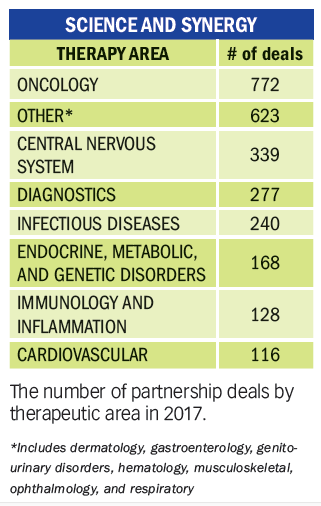
Despite encountering failures along the way, society depends on science to solve the issues and challenges caused by disease. This is readily seen with CAR-T, a living therapy that is offering hope for many.
Science has the chance to pull us across the goal line in the fight against the opioid epidemic, while at the same time generating new opportunities and treatments in the cannabis arena. The challenges are tougher in Alzheimer’s disease and in antibiotic resistance, where novel therapeutics are needed in both, but for the latter, may finally be reaching patients. Essentially, as today’s biopharma pipeline illustrates, it's a matter of continued perseverance.

Joseph Constance is an independent writer and analyst based in New Jersey. He can be reached at jacpub@gmail.com
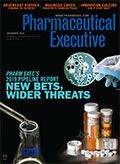
Addressing Disparities in Psoriasis Trials: Takeda's Strategies for Inclusivity in Clinical Research
April 14th 2025LaShell Robinson, Head of Global Feasibility and Trial Equity at Takeda, speaks about the company's strategies to engage patients in underrepresented populations in its phase III psoriasis trials.
Key Findings of the NIAGARA and HIMALAYA Trials
November 8th 2024In this episode of the Pharmaceutical Executive podcast, Shubh Goel, head of immuno-oncology, gastrointestinal tumors, US oncology business unit, AstraZeneca, discusses the findings of the NIAGARA trial in bladder cancer and the significance of the five-year overall survival data from the HIMALAYA trial, particularly the long-term efficacy of the STRIDE regimen for unresectable liver cancer.
Expanding Immune Response Testing to Support Vaccine Development
April 22nd 2025Nigel McCracken, chief operating officer, Virax Biolabs, discusses the expansion of its ViraxImmune platform into areas such as transplant monitoring, vaccine efficacy, latent virus reactivation, and CAR T cell therapy.